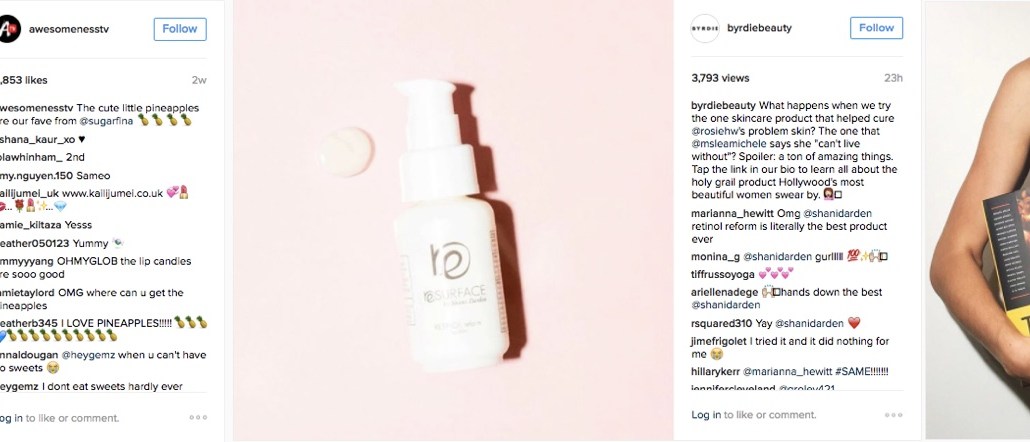Save 50% on a 3-month Digiday+ membership. Ends Dec 5.

As a platform, Instagram might not be ideally suited to serve publishers’ digital needs. But they’ve still figured out how to make money on it.
In the past year, as their audiences on the platform have increased, scores of them have turned to tactics including product placement, Instagram star partnerships and even tools that help them sell from their comments sections.
And while many emphasize that they’re in the early stages, there are bright spots. For Barstool Sports, Instagram is now the biggest driver of sales for one of its top-selling lines of shirts. Goop, the Gwyneth Paltrow-founded site and store, says it’s gotten click-through rates over 80 percent on the platform. Health and wellness publisher Mindbodygreen’s branded content averages better engagement on Instagram than the content it publishes on its own site, and advertiser interest in such branded content has “exploded,” according to the site’s founder and CEO, Jason Wachob.
“We sit at the intersection of content, community and commerce,” Wachob said. “A lot of brands want to play in this space.”
During the first half of this year, Instagram quietly surpassed Twitter as the second-largest social media audience for magazine publishers, according to data compiled by the Association of Magazine Media.
Many of the audiences are still small – just four of the top 100 most-followed accounts on Instagram belong to publishers, according to social analytics firm Socialblade. But they are also fairly engaged, so much so that brands, even those with much larger Instagram followings than publishers, are looking for ways to sneak into publishers’ feeds. “Normally, brands work with publishers for distribution,” said Mariana Rittenhouse, director of brand strategy at Instagram intelligence company Dash Hudson. “But on Instagram, they have distribution.”
By far the most common strategy publishers use is good old-fashioned product placement, where an advertiser’s product will be photographed, and the brand will be tagged in a post published on the publisher’s feed. These kinds of posts are often part of larger digital buys, but the publishers’ conversations with brands often begin around Instagram. “[Brands] want us to put products on our [Instagram] page, but we’re not going to do that unless it’s part of larger, integrated package,” said Louis Roberts, ad sales director at Barstool Sports.
Ad position: web_incontent_pos1
And, if a product is good enough to plug, why not profit when your readers purchase it? With an ever-growing number of publishers embracing affiliate links and other e-commerce strategies, Clique Media Group, the venture-backed startup behind Who What Wear, Byrdie and My Domaine, has applied that strategy to articles associated with Instagram posts: a brand like Byrdie will publish a product-focused post on Instagram, drive people to a related post on their website via a link in its Instagram bio section, which is seeded with affiliate links.
Other publishers use Instagram to push directly to their stores. Barstool Sports plugs its “Saturday is for the Boys” shirts with posts on its feed on Saturday mornings, when most of its readers are still wrestling with hangovers and looking at photos of Friday revelry. Other publishers, including The New Yorker, New York magazine and Complex, have all used posts in their feed to drive sales of everything from books to branded events.
Another common but more complicated source of Instagram revenue for publishers stems from influencer marketing. Publishers have spent years enticing Instagram into the branded content deals they concoct for advertisers. Publishers including Food + Wine and Refinery29 have worked with influencers to create content as part of broad deals they’ve struck with advertisers.
The increased interest in influencer marketing is a major reason why Time Inc. assembled its own networks of influencers, called Time Inc. Connect, to create content for brands.
While many industry observers feel that publishers are still in the earliest days of figuring out how to monetize their Instagram audiences, the ones that are furthest along have things in common: “Our readers are shoppers and our shoppers are readers,” said Kim Kreuzberger, Goop’s head of partnerships and sales.
More in Media

What publishers are wishing for this holiday season: End AI scraping and determine AI-powered audience value
Publishers want a fair, structured, regulated AI environment and they also want to define what the next decade of audience metrics looks like.

Digiday+ Research Subscription Index 2025: Subscription strategies from Bloomberg, The New York Times, Vox and others
Digiday’s third annual Subscription Index examines and measures publishers’ subscription strategies to identify common approaches and key tactics among Bloomberg, The New York Times, Vox and others.

From lawsuits to lobbying: How publishers are fighting AI
We may be closing out 2025, but publishers aren’t retreating from the battle of AI search — some are escalating it, and they expect the fight to stretch deep into 2026.
Ad position: web_bfu
